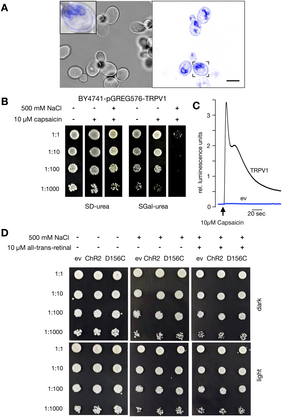Tailoring baker’s yeast Saccharomyces cerevisiae for functional testing of channelrhodopsin
04/13/2023Tailoring baker’s yeast Saccharomyces cerevisiae for functional testing of channelrhodopsin
Höler S, Degreif D, Stix F, Yang S, Gao S, Nagel G, Moroni A, Gerhard Thiel G, Bertl A, Rauhet O. (2023)
PLOS ONE 18(4): e0280711. Doi: 10.1371/journal.pone.0280711
Channelrhodopsin 2 (ChR2) and its variants are the most frequent tools for remote manipulation of electrical properties in cells via light. Ongoing attempts try to enlarge their functional spectrum with respect to ion selectivity, light sensitivity and protein trafficking by mutations, protein engineering and environmental mining of ChR2 variants. A shortcoming in the required functional testing of large numbers of ChR2 variants is the lack of an easy screening system. Baker’s yeast, which was successfully employed for testing ion channels from eukaryotes has not yet been used for screening of ChR2s, because they neither produce the retinal chromophore nor its precursor carotenoids. We found that addition of retinal to the external medium was not sufficient for detecting robust ChR activity in yeast in simple growth assays. This obstacle was overcome by metabolic engineering of a yeast strain, which constitutively produces retinal. In proof of concept experiments we functionally express different ChR variants in these cells and monitor their blue light induced activity in simple growth assays. We find that light activation of ChR augments an influx of Na+ with a consequent inhibition of cell growth. In a K+ uptake deficient yeast strain, growth can be rescued in selective medium by the blue light induced K+ conductance of ChR. This yeast strain can now be used as chassis for screening of new functional ChR variants and mutant libraries in simple yeast growth assays under defined selective conditions.






